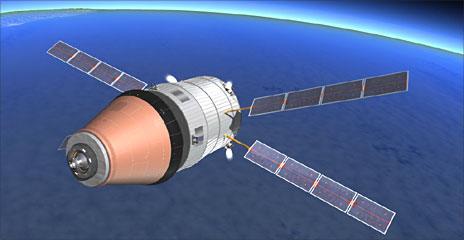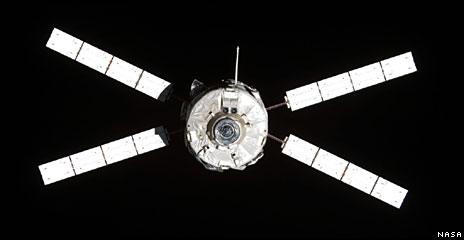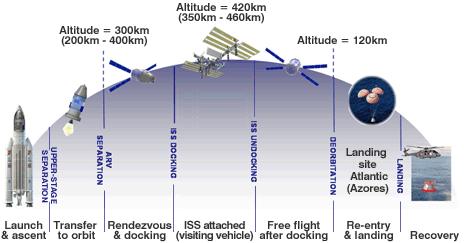Decision needed on European space truck upgrade
- Published

ARV would have a conical re-entry capsule and a more capable service module
European countries will soon be asked if they wish to press on with design work to upgrade the ATV space truck.
The robotic craft takes supplies to the International Space station (ISS), but could be enhanced to return cargo to Earth and even carry a human crew.
Further feasibility work will cost some 150m euros, and nations are likely to decide by the end of the year whether to continue or shelve the project.
Much may depend on how they view future plans for human space exploration.
More freighters are needed to keep the station operational up to 2020, but beyond that date the prospects for the orbiting platform and the ships that service it are not yet fully defined.
This means that states belonging to the European Space Agency (Esa) may be reluctant to commit to an expensive upgrade to a vehicle that may have a limited use.
Luigi Maria Quaglino from Thales Alenia Space (Italy), one of ATV's manufacturers, said he believed the Italian Space Agency (Asi) would be reluctant to approve the enhancement programme.

The ATV is destroyed when it comes back through the atmosphere at the end of its mission
"Asi is not supporting the ARV idea because they think it is a lot of money for a programme which does not have a future," he told reporters.
"Their position is to support the maximum utilisation of the space station, and that includes ATV production because it is part of the logistics treaty [between the space station partners]."
Luigi Maria Quaglino was speaking at this week's International Astronautical Congress in Prague, in the Czech Republic.
The congress is one of the key meetings in the year when the global space community gets together to discuss current issues.
Spaced trucks
The 20-tonne ATV (Automated Transfer Vehicle) flew a maiden voyage to the ISS in 2008. A second truck will launch next year.
The ship has sophisticated automatic rendezvous and docking technology - it can find its own way to the ISS and attach itself without any human intervention.
What it cannot do, however, is return to Earth at high speed through the atmosphere. At present, it simply burns to destruction.

ATV has sophisticated systems to find its own way to the ISS
An Advanced Re-entry Vehicle (ARV) would have that survivability. It could be a significant asset for the space station which, when the US space shuttle retires next year, will have limited means of getting heavy cargo - including science experiments - back to Earth.
Esa initiated a 21m euro feasibility study in 2009 to specify the basic requirements for an ARV. On the basis of that "phase A" work, officials now expect to go to member states to ask for 150m euros to develop the concept further.
Phase boundary
On the table for discussion currently is the idea that the procurement of two future ATVs be dropped in favour of getting the ARVs flying before the end of the decade.
And with the chance that ISS operations could yet be extended deep into the 2020s, there would then be ample time to exploit the new capability.
"If I get 'phase B' approval by the end of the year or the beginning of next year, I can then present an informed proposal for 'phase C/D', the development phase, at the next Ministerial [Council of Esa]," Simonetta Di Pippo, Esa's director of human spaceflight, told BBC News.
"In that way, I can be confident to launch ARV by 2018. But for sure, what we want to do is re-use to the maximum extent possible our expertise on ATV. It is a unique spacecraft."

The re-entry capsule would be cone-shaped
Esa officials, though, are likely to face some tough talking from member states, a number of which are having to operate in very tight fiscal circumstances. Others say ARV is simply not a top agenda item at the moment.
"I represent one of the states that is very much in favour of ARV because this is the future, and Europe should be active in all areas of human space," commented Professor Jan Woerner, chairman of the German Aerospace Centre (DLR).
"However, the priority for Germany is full exploitation of the ISS; and if, within this full exploitation, we have some space for ARV, we would be very happy. But full ISS exploitation has to be the priority."
The ARV has drawn particular attention because it is being designed in such a way that it could eventually be converted to carry astronauts.
At the moment, Europe has no independent crew transportation system, and relies on the US and Russia to get its people into orbit.
But a manned capability for the ARV is not something that is being considered seriously just yet.
Flexible concept
The ARV phase A study describes a vehicle that superficially looks very similar to the ATV. It is of similar length, width, height and mass and launches on an Ariane 5 rocket.
However, the blunt cylindrical cargo carrier on the front would be replaced by a conical capsule with a heatshield for re-entry. And the service and propulsion module that drives the cargo capsule through space would be more versatile than the existing ATV unit.
It could carry unpressurised as well as pressurised cargo, transport new modules to the ISS, and even move elements around in orbit like a tug.
"The ARV service module will be much more versatile, much more flexible, than the ATV service module; and we are assessing options to transport a much broader range of payloads," said Cristian Bank, who leads the ARV study at EADS Astrium.
"That would provide us with many more mission scenarios, some of which would even go beyond the ISS lifetime, because ARV only makes sense if it is doing other missions in parallel or after the ISS," he told BBC News.
If the phase B study were to be approved, it could allow testing of some critical technologies such as the parachute system that would slow the returning capsule just before its ocean splashdown.
